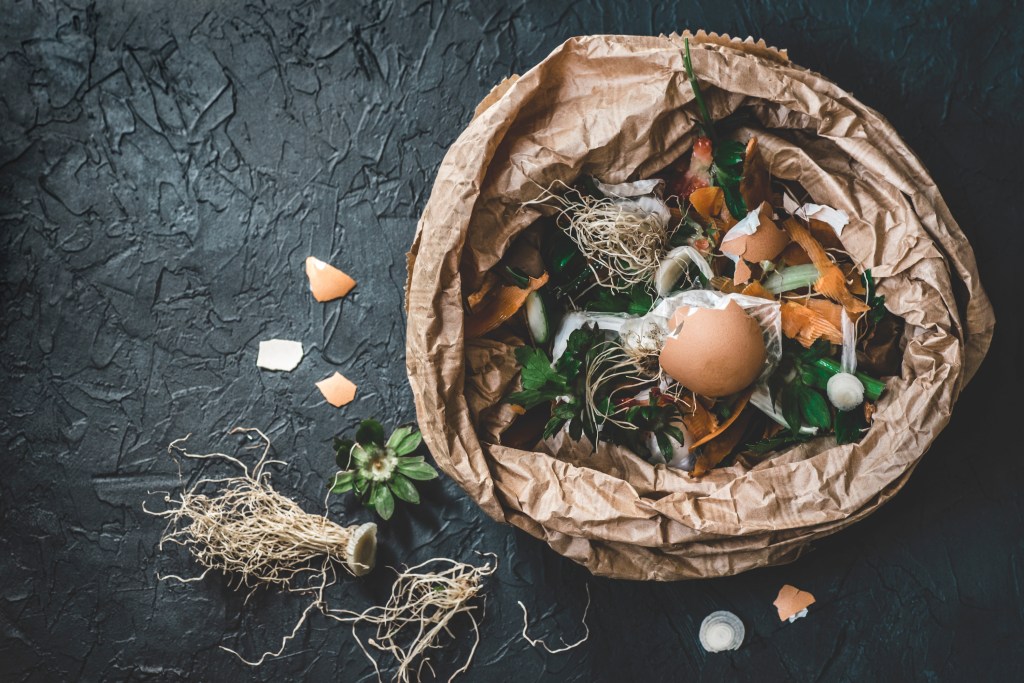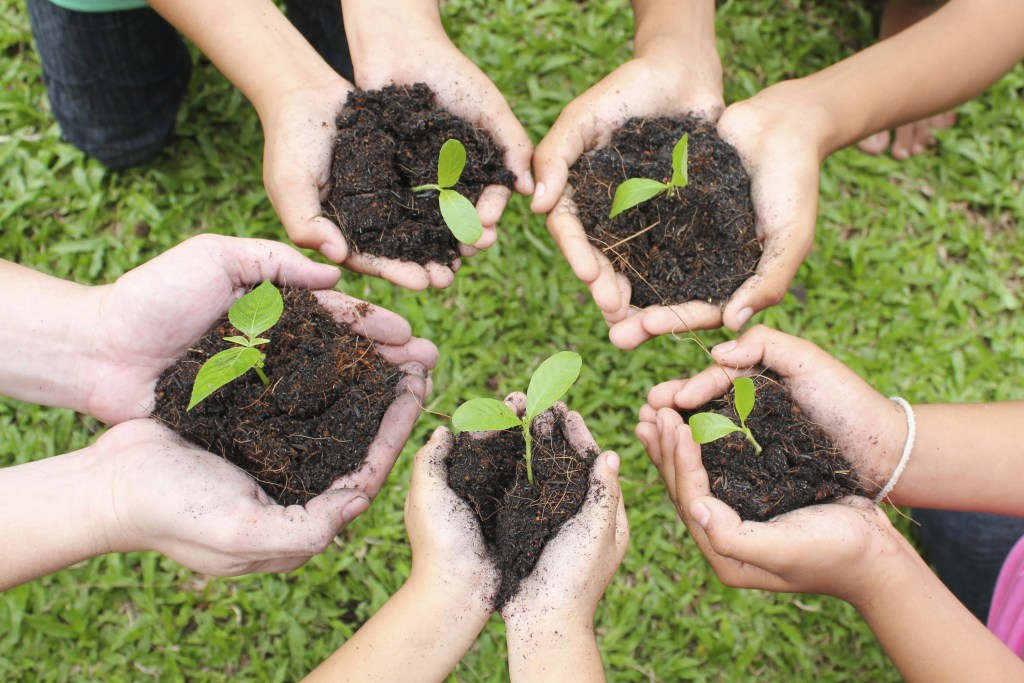Food waste in landfills doesn’t decompose — it rots.
“Decades ago, when we started landfilling everything, it seemed like the modern solution to life,” said Erlene Howard, founder and owner of Collective Resource Compost. “It just wasn’t clear what a problem that was going to become.”
Howard started Collective Resource Compost nearly 11 years ago to address the growing need to divert food scraps from landfill sites. Based in Evanston, IL, the woman-owned food scrap pickup service has composted 14 million pounds of waste from across the Chicagoland area since its inception.
Howard recognized that many people feel like they don’t have the time, energy, or resources necessary to create and tend their own compost piles.
“I wanted a solution for composting, but I lived at that time in a place that didn’t have a backyard, so it wasn’t really possible,” Howard said. “And that’s when I decided that I wanted to do food scrap collection.”
Many compost and food scrap pickup services emerged in cities over the following decade. Some cities, like San Francisco, even mandated recycling and food scrap diversion as a city-wide sustainability initiative in 2009. While food scraps are biodegradable, landfills don’t provide the necessary conditions for biodegradable materials to decompose and release nutrients.
“[Composting is] just repeating what Mother Nature would do if we got out of her way,” Howard said. “But if you flip that and you put the food scraps into the landfill… they end up getting encapsulated without air or sunlight and they start to ferment. That’s what creates methane, which is the most dangerous of the greenhouse gases.”
Methane contributes to climate change by trapping heat in the atmosphere. While it has a shorter atmospheric lifetime than carbon dioxide, methane is more effective at trapping radiation, warming Earth at a rate 84x as much as carbon dioxide. Increased methane production also precedes rises in tropospheric ozone, an air pollutant responsible for 1 million respiratory deaths each year globally.
“When food goes into the landfills, people think that, ‘it’s biodegradable, so it just degrades into the earth.’ But that doesn’t happen because it gets covered with more and more trash,” said Kyle Preuss, Operations Manager at Block Bins.
Preuss joined the small staff of the Chicago-based startup, Block Bins, after living in San Francisco and seeing designated compost bins at every home. Preuss felt a sense of guilt discarding waste into the same bin while in Chicago.
“Basically I didn’t want to change my habits just because I changed cities,” Preuss said.
Started by CEO Dane Christianson in 2019, Block Bins has now diverted thousands of pounds of food scraps from 400 bins. Block Bins used to rely on help from Collective Resource Compost to collect compost. Howard doesn’t fear market competition, but embraces it; she recognizes the need for greater infrastructure to divert as much food waste from landfills as possible. Without city- or state-wide solutions, organizations must build solidarity with one another to address their community’s needs.
With the emergence of pickup services, there are now more reliable avenues than ever to divert food waste. Unlike traditional backyard composting, using a pickup service can be just as easy as common trash removal practices—simply put food scraps into a bucket instead of the garbage can, and the pickup service takes care of the rest.
“You can be as invested as you want. It can take two seconds,” Preuss said. “Or you can be as involved as you want—you could make your own—but for those who want minimal effort for a huge environmental impact, this is a great first step.”
There are many ways to collect food scraps before disposing them into the bucket. Preuss keeps a container in his freezer; Howard lines the container on her kitchen counter with paper. Some stores now even sell compostable bags made from vegetable matter.

The high temperature of commercial composting also allows users to compost a wider variety of materials that they couldn’t successfully compost in their own backyards, including animal bones, cheese, greasy pizza boxes, and wine corks.
“Because of how large they are, the nitrogen carbon reaction that happens actually makes them cook inside, which kills the pathogens in raw meat or dairy,” Howard said. “It also kills seeds, like from weeds and things like that. If you were to put a bunch of weeds in your yard compost bin, it’s not likely that your pile will get hot enough to kill those, so then you would just be spreading weed seeds all over your yard the next season.”
Unfortunately, the cost provides a barrier for both commercial and backyard composting.
Organizations like Block Bins and Collective Resource Compost hope to remedy the price barrier through multi-family bins. Christianson’s vision for Block Bins revolved around community: Users subscribe for $10/month and Block Bins delivers a 32-gallon bucket to the apartment complex, condo association, or neighborhood alleyway. The frequency of pickup then differs, depending on how many individuals subscribe to that bucket.
“We’re trying to launch a new website so it’s easier for us to get people new bins,” Preuss said. “We’ll deploy a couple bins and they’ll have four subscribers in, like, a week.”
Collective Resource Compost also provides 32-gallon buckets for multi-household use, reducing the cost while also starting a community sustainability conversation. For their Neighbor Totes program, Collective Resource Compost offers a shared 32-gallon bucket for $24 per pickup. Howard recommends a weekly pickup for 24 people, but 12 neighbors can elect for biweekly pickups or 6 neighbors can fill it for a pickup every 4 weeks. For this service, each person would only pay $1/week, or $52/year.
For those already paying trash removal fees, paying an additional fee might seem unnecessary. However, Howard recommends considering the longterm cost of landfill overuse.
“Cost goes beyond the money coming out of your pockets,” Howard said. “Even landfilling will get more and more expensive the farther and farther we have to ship our waste away from where we live because of the space we need to landfill it.”
Likewise, composting can jumpstart a chain reaction towards greater individual sustainability.
“And the way that I have seen it happen in my life is: So I start composting and then I say, ‘okay, well then I can’t go to Jewel and use a bunch of plastic bags, I have to use reusable bags,’” Preuss said. “It snowballs a positive mindset for everybody. I think that it’s an easy first step.”
Preuss also realized he no longer needed to use garbage bags. Since his garbage can was no longer filled with food scraps, his waste—now cut in half—contained mostly mess-free, non-recyclable plastics.
Howard and Preuss agreed that a mindset change might be necessary for many individuals to start embracing food scrap diversion; however, once they started, they would notice the various benefits almost immediately.
“Sometimes we get condo associations that email us, ‘but won’t we get more rats because of the food?’” Preuss said. “And I’m like, ‘no, the bins are locked shut! Less rats! It’s less waste.’ If your garbages are just filled with plastic bags, there will be no rats, because there will be no food.”
Many misconceptions about composting persist, including myths that bins will attract pests or smell unpleasant. Food waste in a separate container doesn’t decompose any faster than food waste in a traditional garbage can.
“Most people don’t take out their trash every day… They would probably have food scraps underneath their sink or wherever three days, four days before it would go out,” Howard said.
For those still concerned about the smell, Howard offers a strong rebuttal.
“What’s yuckier [than the smell] is the methane production and the damage that it’s causing to the planet by being in the landfill,” Howard said.
Education about composting can help fill this information gap, as well as teaching younger generations about the dangers of greenhouse gases.
“I just think about the younger generation,” Preuss said. “Both of my parents are teachers, and so if your kids get used to that as the norm, like ‘this is how my house works,’ then you instill that in them when they get older.”

Individual decisions add up, including recycling, composting, and repurposing food scraps.
“I think it’s a great idea on that micro level for each household to take responsibility for keeping their food out of the landfill,” Howard said. “So, I guess your broader question is: Is Cook County, or any community, really ready for all of the food scraps?”
Education alone, however important, doesn’t address the lack of infrastructure and government policy surrounding food scrap diversion.
“Cities and villages need to make decisions about requirements, especially for large producers of food waste to have to take their food out of the landfill,” Howard said. “There are food waste bans out there in the world, and I do think that will continue to be a driving force in how it’s going to actually happen.”
When the landfill isn’t in your own backyard, it’s easy to ignore the dangers and assume bags of garbage simply disappear. However, many communities globally don’t have that luxury. Vulnerable populations often face harsher consequences in an economy of finite space and limitless waste.
“Who wants a brand new landfill set up in their backyard? Who are the communities that will unfortunately be impacted by the ever-growing need to landfill?” Howard said. “So we’re doing our homework around environmental justice and really trying to be a part of the solution for the environment and that justice work.”
Environmental justice entered mainstream consciousness in 1982, following protests in Warren County, North Carolina. Black community members fought the decision by the state government to landfill toxic waste in their community; the state arrested over 500 people and continued to dispose toxic waste in the small town. The term describes how communities of color and low income communities have long faced the immediate effects of our environmental crisis.
Communities who live, work, and play closest to sources of pollution face negative health outcomes, including asthma, reduced lung functioning, and cardiovascular disease.
People living far enough away from sources of pollution may grow apathetic and accept inconvenience as a valid barrier to changing their trash removal routines.
Not only must mindsets change, but people must also apply pressure to elected officials to enforce the largest producers of waste to divert from landfills.
Editors' Recommendations
- Climate change threatens the future of gardens; gardeners may be the solution
- Compost in your own backyard to maximize your blooms for your bucks




